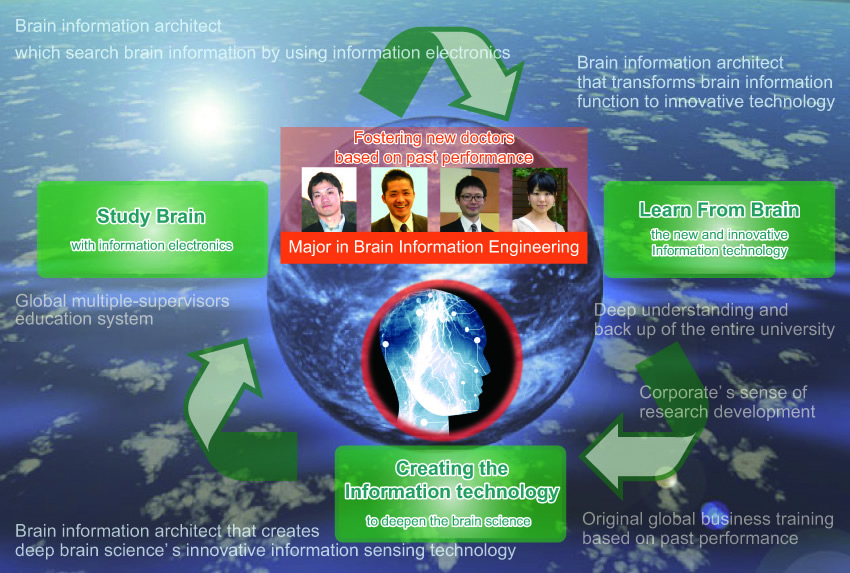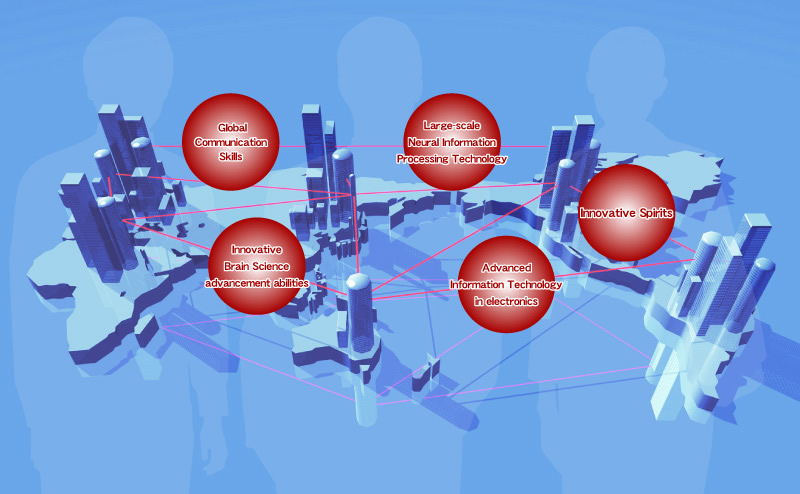Program
Educating desirable human resources for society
The main purpose of the program is to develop the “Brain Information Architect” who can fully apply the sensing deices, transmission and storage, analysis and modeling, and simulation techniques to the wide variety of spatial and time scales that are relevant to brain information, from the genome, protein, neural cells and circuitry, to the individual and society. The “Brain Information Architect” can then connect these elements to solve problems in brain science such as genetics, biological body functions, neural information communication, neural network functions, the functioning of the sensing, acknowledgments, cognition, memory, effective studying, growth and communications, etc.
We expect brain information architects to adapt to the ever-changing world, industry, and environment, and to create new technologies, industries, societies and values.

We reinforce our advanced interdisciplinary electronics technology education by collaborating with the Hamamatsu University of Medicine, the department of medical photonics, in five leading technology education fields: genome function analysis, bio sensing, nanophotonics, high-performance simulation and brain information decoding. We train brain information architects with the following skillset and qualifications:
- Innovative Brain Science advancement abilities: The skillset needed for problem solving in a wide range of fields in Brain Science – Genome Science, Life Science, Neuroscience, and Cognitive Science – and the ability and foresight for pioneering studies in innovative technologies that accelerate research in this field.
- Advanced Information Technology in electronics: This involves applying and developing advanced information technology, such as genome decoding, sensing technology, nanophotonics, brain-information decoding and virtual brain simulation, to solve problems in brain science.
- Large-scale Neural Information Processing Technology: This is an essential skillset for handling a variety of ultra-large-scale and large-capacity sets of neural information. It includes techniques for information measurement, storage and transfer, as well as feature extraction by information mining, ultra-large-scale modeling simulation technologies and visualization of handling techniques.
- Global Communication Skills: Leadership and communication skills are essential for interdisciplinary research and development, as are acquiring a global perspective and language ability.
- Innovative Spirits: Creating the vision to solve and manage the social issues that human beings are facing today, including an aging society with low birth rates, as well as a widening gap in access to medical care and certain negative aspects of our technology heritage.
To nurture these skillsets, we are organizing an education system that goes beyond the boundary of brain science and engineering. We are structuring a new curriculum featuring group educators from Hamamatsu University School of Medicine, domestic and foreign universities and research institutes, and industry leaders. We seek to create career paths with exceptional opportunities.
(Please refer to Curriculum for further information.)
